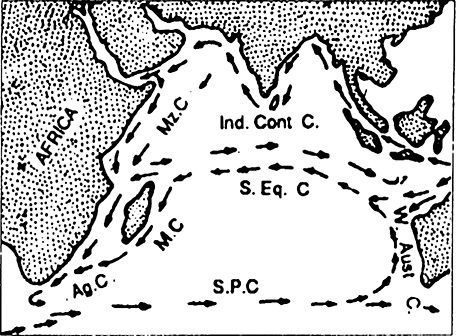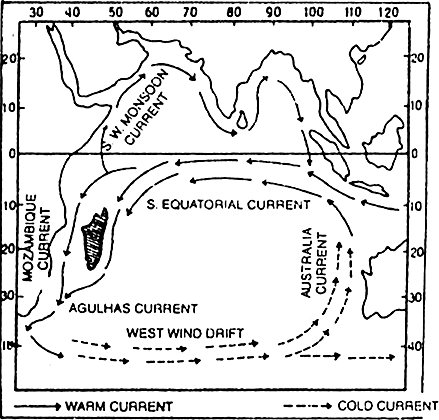|
Spring Tides |
Neap Tides |
|
(i) It is a tide with a range considerably increased from that of the mean tidal levels. (ii) It occurs twice each month around the time of the new moon and full moon. (iii) The high tides are somewhat lower than the average. (iv) It is due to complementary gravitational effects caused when the earth, moon and sun are in a straight line. |
(i) It is tide with a range considerably lower than that of the mean tidal level. (ii) It occurs twice each month during Lunar quadrature. (iii) The high tides are somewhat lower and low tides are somewhat higher than average. (iv) Here tidal production forces do not supplement each other because the moon, the earth and the sun are at right angles. So the velocity of tidal currents slows down. |
1. due to the gravitational pull of the moon and of the sun on the earth.
2. due to gravitational pull waters of the oceans are attracted towards moon. Water being liquid rises higher than the solid crust of the earth. This is known as the high tide. When the level of the water falls, it is known as low tide.
3. due to the rotation of the earth tides occur twice a day at a place.
One tide occurs on the earth surface facing moon and the other tide occurs at the opposite side of the earth.
|
Swell |
Surf |
|
(i) These are wind generated waves in the open sea. (ii) Swell moves in a uniform pattern of equivalent period and height. (iii) They are generated in the open oceans. |
(i) These are also wind generated waves but near the beach. (ii) This is a foaming water which results from the highly dynamic wave activity. (iii) They are found in the bracken zone of a shoreline. |
Give an account of the currents of Indian Ocean.

Currents of the Indian Ocean (Winter)
In the west, South Equatorial Current has two branches. One branch passes through Africa and Madagascar. It is called Mozambique Current. Another branch flows east of Madagascar parallel to the Mozambique Current. It is called Madagascar Current. These two branches meet each other south of Madagascar and form Agulhas Current. It later meets the South Pacific Current which flows from west to east. A branch of it flows along the western coast of Australia from south to north and meets the South Equatorial Current. The current along Western Australia is known as West Australian Current. Ocean Currents in North Indian Ocean :
Summer: In summer, the prevailing winds blow from sea towards land and are known as South-West Monsoon. Under its influence a branch of South Equatorial current turns towards Africa in the west. The current turns towards east from the Gulf of Aden, and takes a round of the Bay of Bengal washing the western and the eastern coasts of India.
Winter : The direction of monsoon winds in winter is just the reverse of that in summer. It is north-east in winter. Hence the an ocean current starting from the strait of Malacca flows along the coast in the Bay of Bengal. After crossing Sri Lanka its flows along the coasts of western India from south to north. It takes a round of Gulf of Aden in the west and begins to flow towards south where its direction is from west to east. Hence, it called South Indian Current.

Currents of the Indian Ocean (Summer)
|
Swash |
Back Wash |
|
(i) It is the movement of a turbulent layer of water upslope of a beach as a result of the breaking of a wave. (ii) It moves and deposits pebbles and conches along the beach. |
(i) It is the movement of marine water down a beach, under gravitational influence after breaking of a wave. (ii) It gives a seaward movement to the beach material. |
